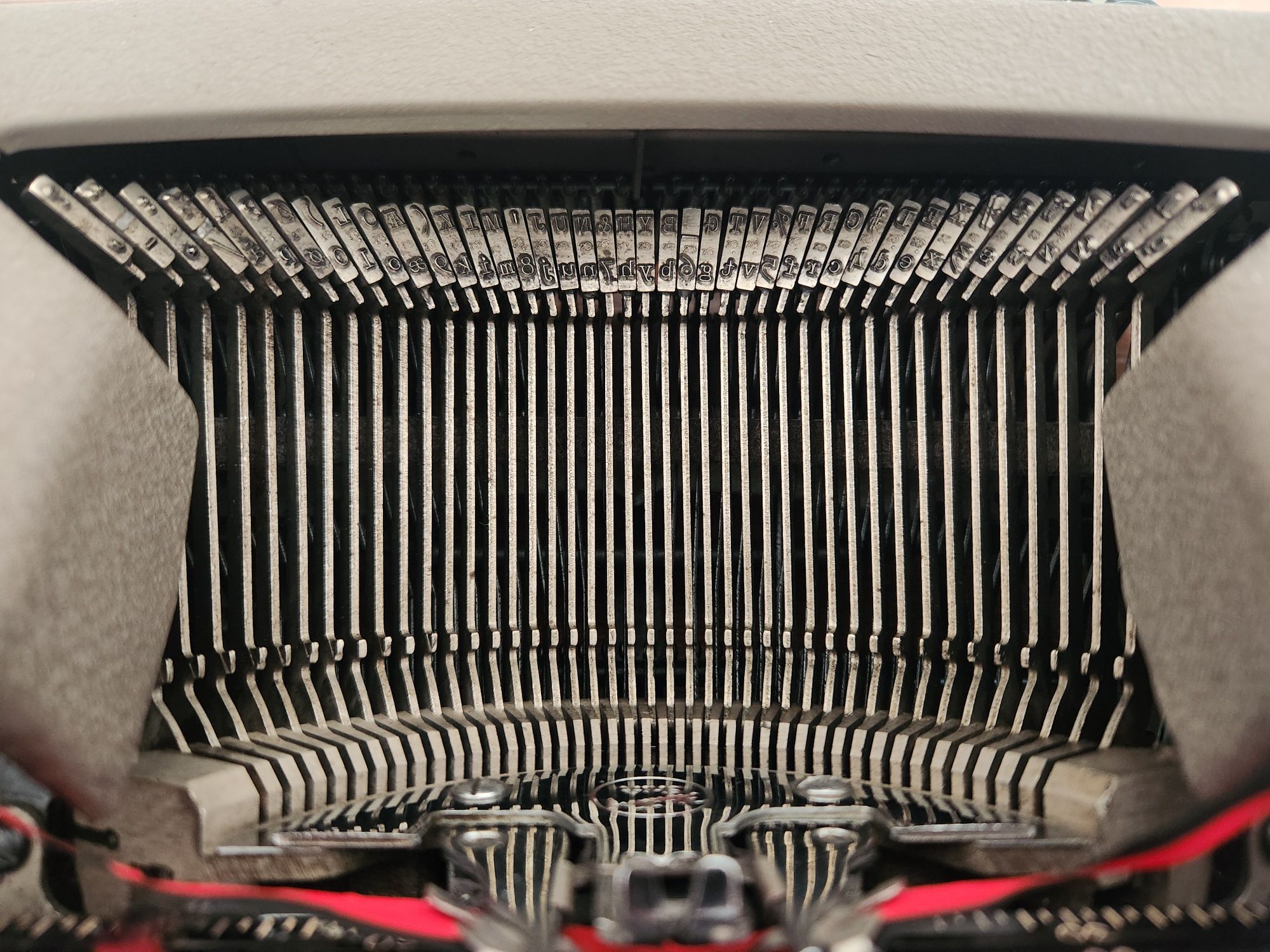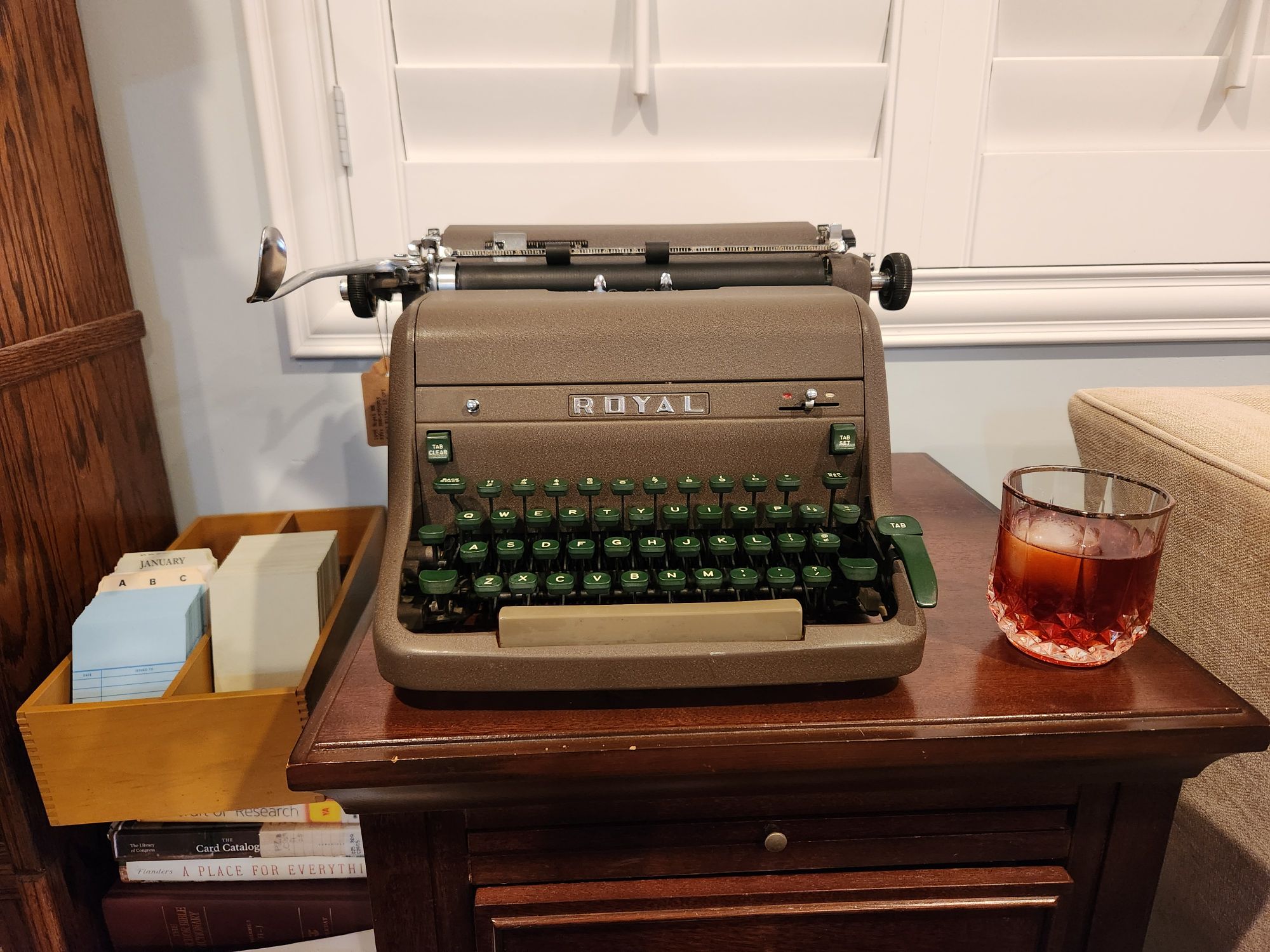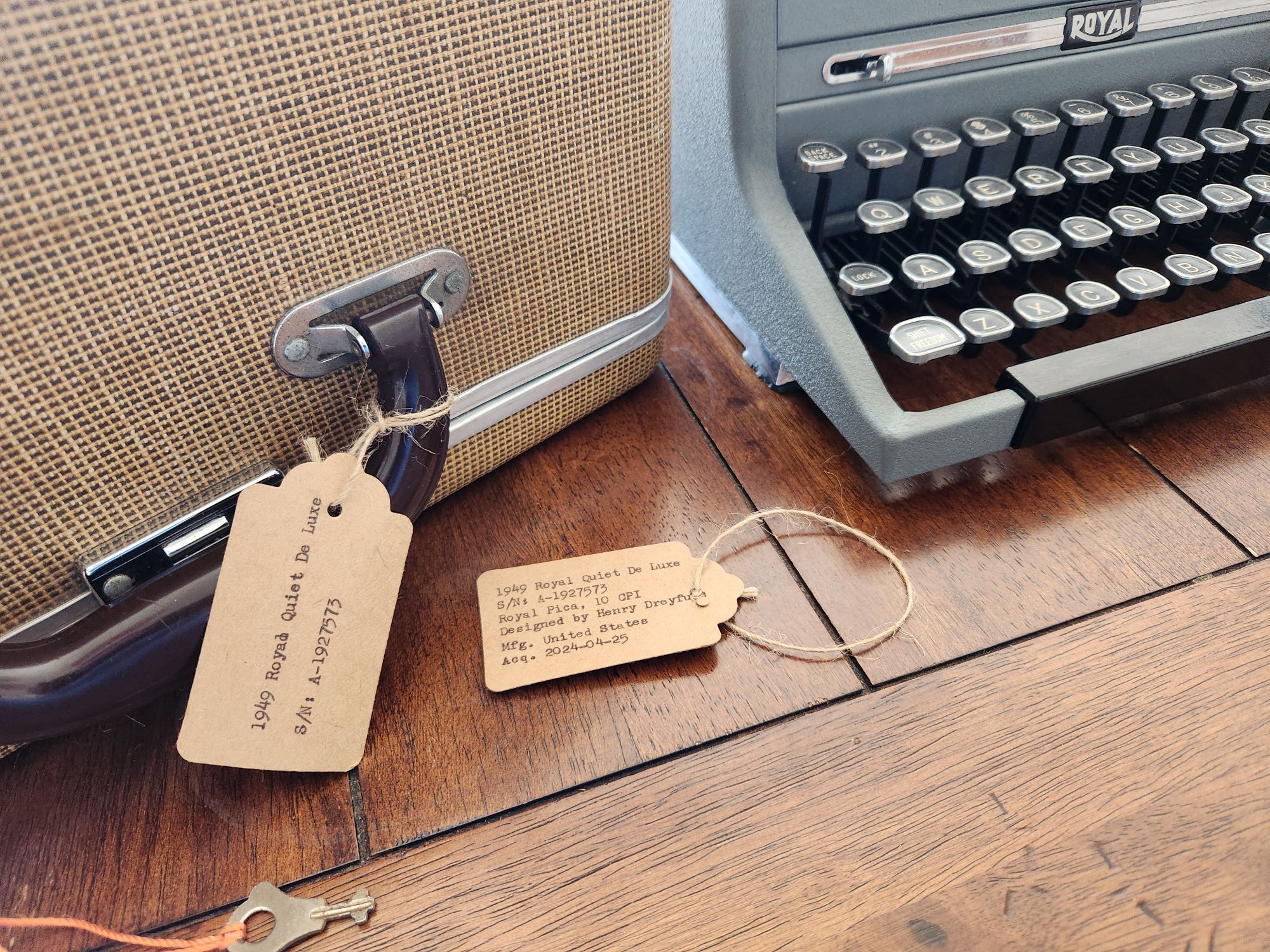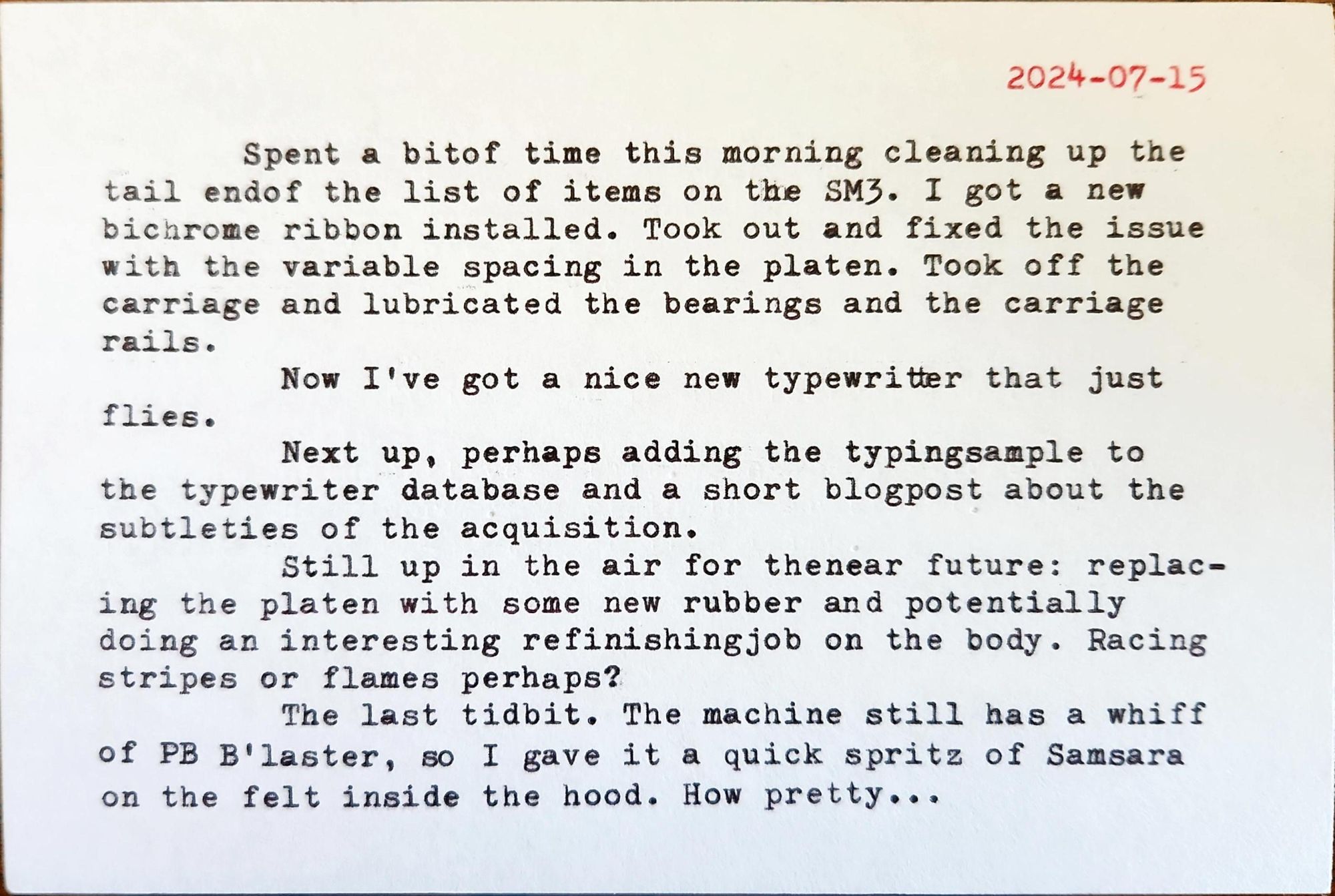Most typists are hobbyists coming to the space with little to no knowledge. Often they’re further hampered by the fact that they don’t have the original manual for their machine and so can’t look up the original equipment manufacturer’s recommendations even if they existed in the original manual. Hint: few manuals gave good advice about this other than to wipe them down weekly and not to let eraser cast-offs go into the machine—anyone who’s had a few typewriters knows how that advice went over historically. Other manuals will recommend regular or annual servicing by technicians who aren’t as ubiquitous as they were back in the day.
Perhaps we ought to harken back to early World War II when typewriter manufacture ceased the first time, typewriter donations to the war effort went up thereby making them more valuable on the domestic front, and the typewriter repair workforce went off to the front? The U.S. Government made a concerted effort to help preserve and protect the machines in circulation with both the War Department making and circulating films and the Treasury Department publishing manuals like Typewriter Care (1945).
When modern typists do get information, it’s often colloquial and under-informed or it’s based on someone’s everyday experience elsewhere or grounded in some small amount of common sense. Many times its outright bad. This is why so many people will turn to everyday household items like rubbing alcohol, cotton swabs, gun oil, sewing machine oil, 3-and-1 oil, and WD-40 to clean and lubricate their machines. These items have been used for these purposes in other arenas and they’re often readily available in the average users’ homes. This readiness to hand will almost always beat a trip to a specialized store to purchase custom solvents, oils, and/or appropriate cleaning tools and dispensers with which they have less first-hand knowledge.
Worse, solid cleaning and lubricating advice by modern day typewriter repair people isn’t easily found or uncovered. (Though it does happen sometimes.) Even if it were, they’d all have a variety of suggestions and practices which were individualized based on their own experience and training as well as the time period in which they learned and practiced it. There are a few good ones on YouTube, but broadly they’re not recognized by a more mainstream public. The few in the type-o-sphere who are better known also have a variety of techniques and methods, and frequently have more custom tools and dispensers at hand than the average home mechanic/typist.
We also don’t have books like Hints for a Happy Typewriter (Bryan Kravitz, 1983), which dispenses some relatively useful advice to the average home typist when manual typewriters were still in use, but about to wane with the increasing ubiquity of electric machines, and the advent of word processors and computers. Even in this brief primer, some of the suggestions would seem quaint for the current home typist-mechanic who now ought to have more knowledge at their disposal and may not be able to rely on a local repair shop being just around the corner.
A search for “how to clean a typewriter” unearths a variety of really good resources in the top 10 hits including the typosphere’s Richard Polt‘s excellent advice. Yet somehow people want to ask on Reddit everyday without searching either the internet or the Reddit sub itself because advice from complete strangers with no bona-fides is somehow really valuable in a field of practice which hasn’t advanced a lot in the last 50 years.
Many years have passed since the Original Equipment Manufacturers (OEM) made these machines, and during that time, materials for cleaning and servicing them have shifted and changed. In some cases they don’t exist anymore, or have changed and become better.
As an example, in the early years, typewriter manufacturers including this Underwood manual from 1920 recommend using gasoline to clean one’s type slugs. This was common practice until Stoddard’s formula (aka Varsol) was invented in 1924 for safer use in dry cleaning. Surely no one is using gasoline anymore despite the ubiquity of gasoline in our environment. It’s highly flammable, it’s difficult to dispense, and it smells dreadful. Surely it had gone out of vogue by the time of the OPEC oil embargo in 1973.

Later on people used Roytype Typewriter Type Cleaner in 2 ounce bottles which was touted as “non inflammable”! I’m sure that 2 ounces of Roytype cleaner was priced higher than a gallon of mineral spirits today. If you’re a purist, perhaps you’re buying new original stock (NOS) online, but at a crazy mark up?
Another bygone example comes from Kravitz’s 1983 home handbook mentioned above which, in addition to alcohol, recommends the use of trichloroethane as a solvent for cleaning type slugs and internals. Trichloroethane manufacture and use has almost completely disappeared since 1996, when it was identified by the Montreal Protocol as a contributor to ozone depletion.
When mineral spirits, lacquer thinner, and other industrial solvents are reasonably available, they’re often in large cans and require transfer into smaller bottles with custom tips for more easily dispensing into typewriters. Taking the time to do this with a good brass-bristled brush is additional work when compared to the alcohol and Q-tips or extra toothbrushes that most people already have at home.
Then most of the common advice about these more caustic degreasers includes the fact that they shouldn’t be put on platens, plastic, paint, decals, or other surfaces which can cause them to dissolve, melt, or otherwise damage them. How many home mechanics are going to remove the requisite typewriter body pieces to properly clean their machines when most are afraid of taking off even the most easily removed screws on body panels? Fear of destroying the exterior of their machines is demotivating. It’s even more demotivating when you take it all off, clean it out, put it back together only to realize the next day your keys are still sticky and need an additional treatment (or two). Was blowing the solvents and dissolved dirt and oil out with compressed air really that necessary? (Yes) Why didn’t anyone tell me I should wait a half a day or more to make sure it would really be fully cleaned out?
And of course, after all that, you mean to tell me that Duane of Phoenix Typewriter has been using lacquer thinner to clean platens and rollers for over 40 years…
Storage and usage conditions also need to be taken into account, both for the products as well as for the typewriters themselves.
Many solvents are not only toxic, but highly flammable. In the case of most (and especially substances like gasoline and naphtha, which is literally used as lighter fluid) care needs to be taken to prevent potential fires as well as having proper ventilation.
On the typewriter side, their frequency of use and the conditions in which they’re stored are going to vary widely from the person who has one on display for infrequent use to the collector who has hundreds which are also in infrequent use to typists who have one or more in regular use, but who also aren’t using them with the frequency of a transcriptionist from the 1950s who typed for eight hours a day.
For the uninitiated, Mineral spirits (US) or White spirit (UK), also known as mineral turpentine, turpentine substitute, petroleum spirits, solvent naphtha (petroleum), varsol, Stoddard solvent, or, generically, “paint thinner”, is a petroleum-derived clear, transparent liquid used as a common organic solvent especially in painting. Just the number of names and varieties of mineral spirit become off-putting to most typists. Which one is the “right” one? (In daily practice, really any of them for sale at the local hardware, paint, or art supply stores will work.) Add this to recommendations of other types of automotive degreasers (like carburetor cleaners, engine degreasers, etc.) which come under the brand names of a huge variety of companies all of which have different ingredients and you’re asking for a mess, particularly when these enter the colloquial advice space. And how many are regularly warning their users that some of these degreasers stink to high heaven in comparison to mineral spirits?

Naturally the underwhelming advice to try isopropyl or rubbing alcohol and Q-Tips seems lovely and expedient. No serious typewriter mechanic would recommend rubbing alcohol of any sort because it contains water and is more likely to cause subsequent rusting to typewriter internals. Even industrial grade isopropyl will have a water in it as well as keytones and acetones which, again, will tend to strip paint and melt plastic. It doesn’t help that isopropyl isn’t the greatest degreaser, though with some mechanical friction, it will certainly help clean up and wash some material out when it’s the only thing available. The better advice is to use one of the family of mineral spirits.
Some materials may be used more frequently by some typists solely because of their alternate uses in the home/garage and thus ease of accessibility. Susan, who likes working on her ’65 Corvette on weekends, may be more likely to have carburetor cleaner out in the garage, so naturally that’s what she’ll want to use to degrease the internals of her typewriter. Meanwhile, her husband Bob who loves his matte Batman-blue fingernail polish is more likely to use his nail-polish remover (aka Acetone) to clean off his type slugs on a weekly basis. Once they’ve appreciated having done this, they’re far more likely to recommend these methods to others. Perhaps if their 10 year old son Jimmy was consulted, he’d recommend the expedience of his Silly Putty for typeface cleaning because he knows it’s a reasonable facsimile of Eberhardt Faber’s Star type cleaner from the 1940s. (And it can be fun to play with when the muse isn’t visiting your typewriter desk.)
Now, the worst of the problem is that most of the sources of misinformation spread are typewriter fora on the internet. Every day someone shows up on one of the common typewriter spaces on Reddit or Facebook asking how to fix and or clean a typewriter. (No one thinks to search these spaces to see the answer from the day before.) The answer they get will naturally default to the lowest common denominator because professional typewriter repair people and mechanics are almost never the ones showing up to answer the question. They’re going to get the same regurgitated colloquial and anecdotal advice everyone else got or used. It will continue to spread on this way until someone aggregates actual advice from trained typewriter repair people. If only we had a solid wiki for documenting, footnoting, and referencing all this sort of advice? Fortunately most of the colloquial advice is close enough, easy enough, and works relatively well.
Even if typists were advised to use WD-40, things wouldn’t be horribly bad as long as they were daily typists who protected their machines against dirt and dust and had them serviced occasionally. WD-40 has been and can be used as a form of degreaser and lubricant for some applications and as long as it isn’t set to dry out and freeze up in combination with dust and dirt most typewriters might fair well enough with it. The bigger problem is when one uses it temporarily and then leaves their typewriter to sit for months or years at a time at which point the isoparaffin, dust, and dirt are going to have solidified and frozen the machine up again, potentially worse than before. I shudder to think of the number of perfectly good dirty typewriters people have thrown out over issues like this. (Hopefully only marginally more than those who disposed of machines because they accidentally had them on the stencil setting.)
Certainly typewriter shops love buying these “damaged” machines for pennies on the dollar, spending a few minutes dousing them with mineral spirits, blowing them out and marking them up hundreds of dollars. (At least this is better than the bottom feeders buying them from Goodwill and marking them up significantly without any repair work at all.)
Oiling Typewriters
When it comes to oiling advice all the same factors about knowledge and materials come into play. What should be oiled and what shouldn’t? What types of oil should I use? 3 in 1 oil, silicone sprays, mineral oils, gun oils (like Rem Oil), sewing machine oil, or other forms of light machine oil? Most people are sure to have one or more of these available at home already, but they’re also likely to have it in larger quantities either in liquid form or in spray can form which means they’re going to dramatically over-oil their machines.
Generally, over-oiling isn’t a problem when the machine is in regular daily use and some level of service is given to it every few years. It will get flushed out and re-applied frequently enough not to be an issue.

But are all modern typewriter users using their machines every day like they were in the past? When a machine sits on a shelf for too long, this oil is going to pick up particulate matter and tend to gum itself up again. As a result, collectors with large collections are probably well-advised to stay away from heavily oiling their machines in much the same way that they don’t want to leave ribbons on their unused machines as they’re prone to dry out over time or leave their paper release levers engaged which is prone to flattening out your platen and rubber paper rollers over time. (You’re guilt of these, I know you are. Go ahead and fix it now on those dozens of typewriters sitting idle in your collection.)
Here the best general advice is to provide very light machine oil in very small quantities and placed in targeted areas including the carriage rails, ball bearings, and, when necessary, on type bar linkages.
What you don’t want to end up with a decade hence is “Frozen Facit Syndrome”, a description common to old Facit typewriters which frequently have a frozen escapement mechanism because, as is sometimes colloquially stated, “someone at Facit thought it would be fun to use cod grease”.
Oiling the segment can be the most problematic as most typewriter segments were machined with incredibly close tolerances for movement against them. Any sort of oil (and especially WD-40) will tend to not only dry out over time, but because the segment is the most exposed internal part of the typewriter, it will gather more dust and dirt than other parts. The close tolerances then close up with gunk and the type bars have more friction eventually causing them to freeze up.
Where to from here?
Colloquial advice is sure to continue apace online. How, then to keep it reasonably solid?
Perhaps we might design a questionnaire to send to typewriter repair shops to see what the state of the art was? Then future hobbyists and typewriter repair schools will have better resources for teaching the cleaning and maintenance portions of their curricula.
Maybe someone will aggregate all the cleaning product recommendations and order them from least abrasive to most, from least toxic to most? This would allow the novice to start simple and increase the power as necessary or appropriate.
Maybe a more comprehensive wiki like The Typewriter Wiki will fill the space for long term advice with proper referencing and supporting materials?
References
Maintenance of Office Machines. 16 mm. Vol. MN-1513. United States Navy Training Film, 1943. https://www.youtube.com/watch?v=ocdxgkxKAKo.
Hausrath, Alfred H., and Eugene L. Dahl. Typewriter Care. Edited by Walter K.M. Slavik. Federal Work Improvement Program United States Civil Service Commission and Government Division, U.S. Treasury Department, 1945. http://archive.org/details/twcare-1945.
Munk, Theodore. “The Typewriter Database,” 2012. https://typewriterdatabase.com/.
Pearce, H. G. Complete Instructions: How to Repair, Rebuild, and Adjust Underwood Typewriters With Handy Reference for Locating Trouble Quickly. Bridgeport, CT: Typewriter Mechanics Publishing Co., 1920. https://johnesimmons.com/Typewriter/Articles/Manualpdf/Underwood_Repair_Manual.pdf.
Polt, Richard. “The Classic Typewriter Page : All About Typewriters,” 2009. https://site.xavier.edu/polt/typewriters/index.html.















